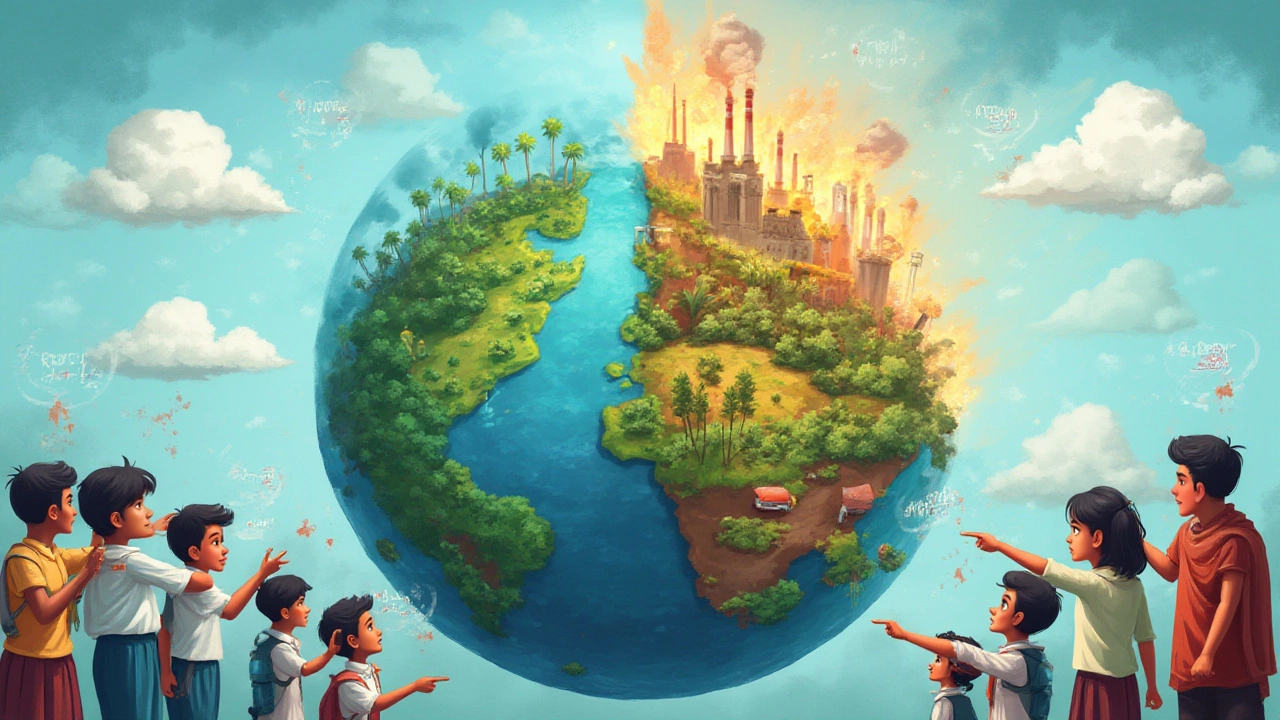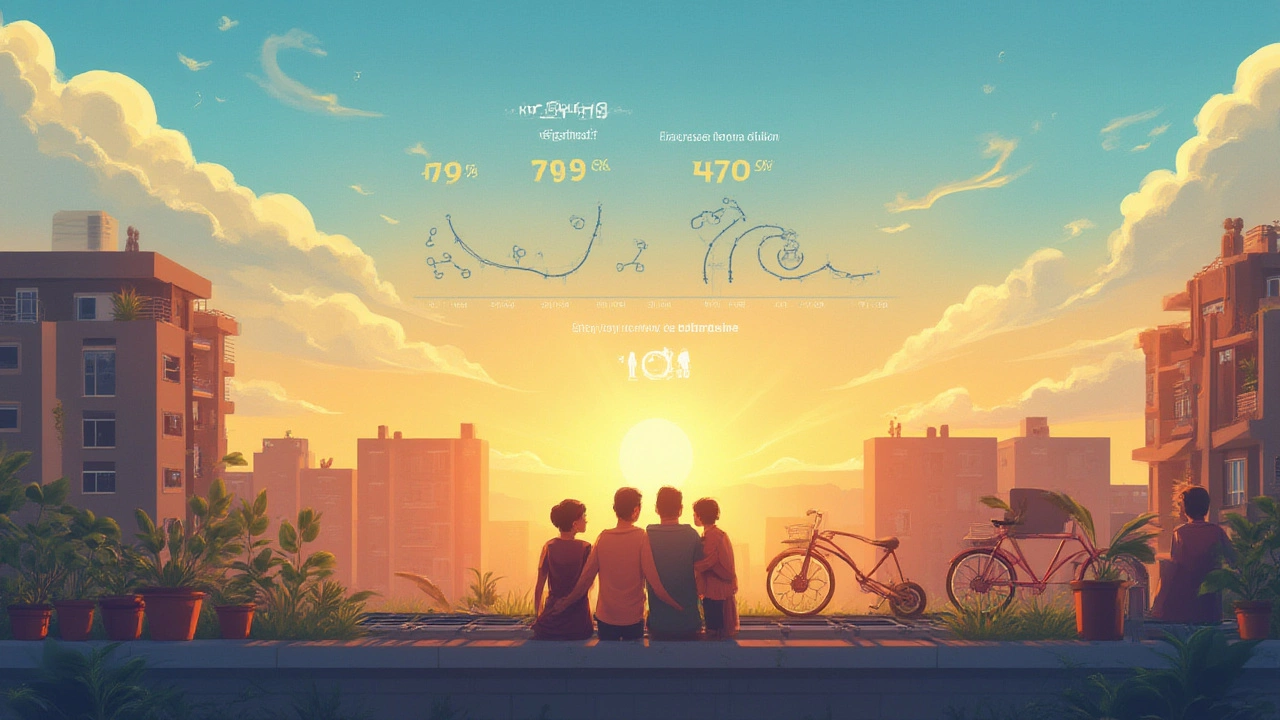How Much Global Warming Is Caused by Humans? Surprising Data Revealed
 Aug, 1 2025
Aug, 1 2025
If you want to stir up an argument at a barbecue, try bringing up the question: “How much global warming is actually caused by humans?” Some will say it’s a natural cycle, some will blame industry, others might quote random numbers or conspiracy theories they read online. But scientists haven’t been leaving this up to guesswork. They’ve been investigating this for decades, crunching numbers, and putting satellites in the sky to measure it down to decimal points. Here’s something wild—almost every major peer-reviewed study done over the last ten years pegs human activity as responsible for over 100% of the global warming observed since 1950. Yes, you read that right: humans are causing all the warming, and actually a bit more, since natural factors seem to be keeping things slightly cooler than they’d otherwise be.
The Science Behind Human-Caused Global Warming
Let’s unravel where those eye-popping numbers come from. The Intergovernmental Panel on Climate Change (IPCC)—probably the planet’s most quoted source on the subject—combines thousands of climate studies every few years. Their 2021 report flat out says: “It is unequivocal that human influence has warmed the atmosphere, ocean, and land.” In other words, there’s zero doubt in the scientific world. How much? The latest findings put the figure at between 98% and 123% of the warming since 1950, according to a 2013 paper in Nature Geoscience updated for recent years. That extra 23% above 100% comes from the fact that without us, Earth might have cooled slightly—the planet’s natural cycles, like lower solar activity and a few volcanic eruptions, have actually pulled temperatures in the other direction. Humans? We’ve blown right through that with our tailpipes, agriculture, coal plants, and endless appetite for energy.
The main culprit is greenhouse gases, especially carbon dioxide (CO2). Factory smokestacks, cars, planes, cows burping out methane, deforestation in the Amazon—these pump heat-trapping gases into the sky at a record pace. Since the start of the industrial revolution, atmospheric CO2 levels have jumped from about 280 parts per million to over 420 ppm by 2025. Scientists measure exactly how much energy all these extra gases trap. For instance, CO2 is responsible for roughly three-quarters of all human-caused global warming. The rest comes from methane, nitrous oxide, and a group of weird industrial chemicals called fluorinated gases. To picture this: since 1880, global surface temperatures have gone up about 1.2°C. About 1.1°C of that is thanks to human activity, with the rest coming from natural factors and a bit of rounding out. That’s not just a hunch. Researchers track everything from tree rings to satellite data and ancient ice core bubbles—the evidence lines up everywhere you look.
People sometimes say things like, “But what about the sun, or volcanoes, or natural CO2 from forests?” It turns out all these have been studied up, down, and sideways. Solar output has actually dropped slightly since 1970, meaning the sun can’t be the driver here. Volcanic eruptions can temporarily cool the Earth by blocking sunlight with ash, not warm it. Natural sources of CO2 are stable and balanced by sinks—plants and oceans sucking it back in—unless we chop down forests or warm up the ocean so it absorbs less. Human activity is that one part throwing the balance totally out of whack.
Check out this snapshot of what the various sources mean in numbers:
| Source | Estimated Contribution To Warming Since 1950 |
|---|---|
| Fossil fuels & Industry | ~75% |
| Deforestation & Land Use Change | ~11% |
| Agriculture (mainly methane, nitrous oxide) | ~14% |
| Natural factors (volcanoes, solar changes) | Negative or near zero |
So, the next time you hear someone joke that humans can’t change the climate, you’ve got both the numbers and the receipts to back it up.

Breaking Down the Impact: What Human Activities Contribute Most?
So it’s humans, all the way down. But which of our activities are the biggest villains in this global murder mystery? There’s always finger-pointing—planes, cows, your neighbor’s massive pickup, that old coal plant on the edge of town. Here’s how scientists actually divide it up:
- Energy production and use: Power plants burning coal, oil, and gas are easily the top contributors—think about every click on a light switch, every phone charge, every time your heater or air-conditioner flips on. Electricity and heat production combined make up close to 25% of global greenhouse gas emissions. Add transportation at another 14%, and you’re looking at nearly 40% from just keeping the lights on and moving around.
- Land use and agriculture: Deforestation is a double-whammy—not only do we lose the trees that pull CO2 out of the air, but the process of burning or rotting wood also releases carbon. Rice paddies and cattle are methane machines; fertilizer-heavy crops like corn and wheat pump out nitrous oxide. Together, agriculture, forestry, and land use changes are behind about 24% of emissions.
- Industry: Making cement, steel, chemicals—these aren’t glamorous, but they’re essential. Industry processes, separate from the energy they use, create about 21% of global emissions. Even as some manufacturing gets cleaner, others lag way behind.
- Waste: Surprisingly, garbage isn’t blameless. Landfills pump out methane as our banana peels and pizza boxes decompose. Poorly managed waste and untreated sewage together add up to about 3% to 5% of the problem.
It might feel a little overwhelming. After all, how do you personally compete with billion-dollar industries and national power grids? Well, the good news is there are simple steps that really do make a difference, even one person at a time. Swap out those old bulbs for LEDs, upgrade to an efficient heat pump, use public transport, eat a little less meat, or even just spread the word. For households, heating and cooling, personal cars, and food waste are the biggest manageable levers.
It’s not just about guilt-tripping. There are real payoffs, too. A University of Oxford study found that widespread adoption of a mostly plant-based diet could cut global emissions by up to 8%. According to the International Energy Agency, energy efficient appliances and home retrofits could shrink home energy use (and bills) by up to 40%. Cities with robust public transit and bike infrastructure see their emissions per capita drop by as much as 60% compared to car-heavy cities. And if you think recycling is pointless, the EPA estimates that Americans avoided over 180 million tons of carbon pollution through basic recycling and composting in a single year.
It all adds up. Every small action pushes the big system just a little closer to sanity—especially as governments notice what people care about and start rewriting the rules for the biggest polluters to follow.

Debunking Myths and Taking Real Steps That Matter
If there’s one thing people love more than blaming each other, it’s trading climate myths at family gatherings. “It’s just volcanoes!” “The Earth’s always changed!” “One country can’t make a difference!” The scientific answer is usually less dramatic, but also much more powerful.
Myth-busting time. First: volcanoes. Mashable fact, courtesy of NASA: all volcanoes on Earth put together emit about 1% as much CO2 as humans do each year. Second: natural cycles. Yes, they exist, but for the last 150 years, natural influences actually should have led to cooling, not warming. Human fingerprints show up in everything from atmospheric chemistry to ocean heat, glacier retreat, and plant blooming seasons.
Third: “But China (or the U.S., or India) pollutes more than me, why bother?” True, the top few countries account for a huge chunk of emissions. But climate change doesn’t respect borders, and the math of emissions is relentlessly global. Per capita, countries like the U.S., Canada, and Australia are still among the world’s largest polluters, and choices made in these places set tech and policy trends everyone else follows. In fact, data shows early national action often creates new green tech and jobs—California’s tough rules on cars in the 1990s triggered global progress toward clean vehicle tech.
If you want to shrink your carbon footprint in a way that counts, start with these practical steps:
- Electrify what you can: Switch out gas stoves for induction, get a heat pump, or consider an electric vehicle when you’re next in the market.
- Go renewable: If you can, opt in to green power from your utility, put solar on your roof, or join a local solar project.
- Eat smarter: Dial down beef and dairy, eat more veggies and grains—the emissions gap between a steak and a lentil stew is bigger than you’d guess.
- Vote and speak up: Policies like carbon pricing, efficiency standards, and green transport get real traction when voters show they care. Your voice really does count.
- Travel efficiently: Walk, bike, or use public transport when possible. For long-distance trips, consider high-speed rail or try to fly less.
- Waste less: Recycle, compost, and skip the single-use plastics.
Want to see where you stand? There are some handy carbon footprint calculators online. The EPA and World Resources Institute both offer calculators that break down your personal and household emissions in a few minutes, along with tips for improvement based on your real life—not a guilt trip, just the numbers.
It’s worth remembering: Our planet is actually incredibly resilient. The moment we stop pumping extra greenhouse gases into the air, nature gets to work absorbing and balancing again. That slow-down isn’t just theory—it already happened during the first COVID-19 lockdowns, when the world saw a record 7% drop in emissions. But the bigger lesson is that the choices of millions (or billions) do swing the outcome.
The bottom line is clear. Humans are the main force behind modern global warming— not random volcanoes, not mysterious solar cycles, not some natural destiny. Armed with some real facts and a few grounded changes, we can do something about it. Who knew a barbecue argument could start a planet-sized change?